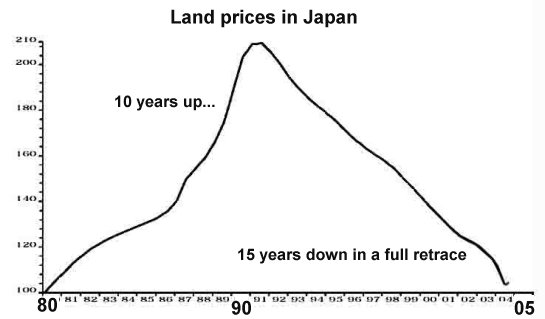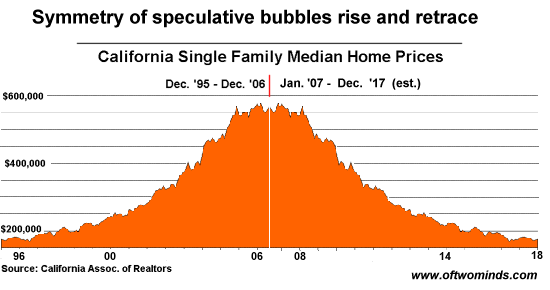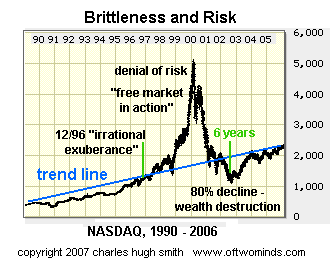

|
| weblog/wEssays archives | home | |
|
Two Irresistible Reasons Housing Will Retrace to 1997 Prices (August 23, 2007) Two historically irresistible patterns suggest speculative-bubble housing values will eventually retrace back to their 1995-1997 levels: To get started, let's stipulate that the Great Housing Boom of the past decade was not a housing boom--it was a speculative debt-fueled bubble which happened to occur in the asset class known as real estate. As a speculative bubble, it shares the same characteristics as other speculative manias in tulips, stocks, toilet paper, etc. (Note that there is one key difference between worthless stock certificates and toilet paper: the TP has a practical use.) Let's look at a speculative bubble in real estate which is finally running its course: the one which has unfolded in Japan over the past 15 years: 
While the symmetry isn't perfect--the decline took 50% longer than the rise--for purposes of illustrating what lies ahead I've prepared a chart of California housing prices: 
 Speculative bubbles in the stock market tend to shoot up and then plummet in relatively
short time spans. Here we see that the dot-com era bubble in NASDAQ took a mere 3 years
to reach euphoric heights in which risk was banished, and a roughly similar length of time
to give up all the bubble's gains, and then some.
Speculative bubbles in the stock market tend to shoot up and then plummet in relatively
short time spans. Here we see that the dot-com era bubble in NASDAQ took a mere 3 years
to reach euphoric heights in which risk was banished, and a roughly similar length of time
to give up all the bubble's gains, and then some.
Real estate trends stretch out over much longer time spans, and as a result we can foresee a lengthy, painfully drawn-out decline in housing values over the coming decade. Just as stocks break free of fundamental metrics of value in speculative manias, so too do houses. But just as stocks retrace to historical levels of price-earnings ratios, so too will housing retrace to historical levels of income-to-value ratios. Historically, this is about 3-to-1: long-term, houses cost about 3 times household income. Since the median household income in the U.S. is abour $46,000, U.S. incomes would support house values of abour $125,000 - $140,000. As I have noted before, my parents/step-parents each bought houses in highly desirable locales in the early 70s (Honolulu and Pasadena) at 2:1 (twice annual income) and 4:1 (four times a schoolteacher's annual income to buy in highly desirable Manoa Valley in Honolulu.) As recently as 1997, friends were purchasing small homes in very desirable S.F. Bay Area communities for $160,000 - $175,000--four times a modest (for this area) household income of $40,000. In other words, to return to a normal trendline, one that was in place a mere decade ago, even the most desirable areas will command no more than 4 times median income. That would put house prices in Honolulu, the S.F. Bay Area, West L.A., Connecticut, Northern Virgina, etc. at about $180,000 - $200,000 -- not $600,000. New correspondent Jim V. provides an excellent overview of how the market could return to historical norms: After reading yours and other blogs I now have a firm understanding of the housing bubble and credit crisis.Thank you, Jim. Well said Thank you, Dan B., ($25) for your unexpected and very generous donation to this humble site. I am greatly honored by your support and readership. All contributors are listed below in acknowledgement of my gratitude. For more on this subject and a wide array of other topics, please visit my weblog. copyright © 2007 Charles Hugh Smith. All rights reserved in all media. I would be honored if you linked this wEssay to your site, or printed a copy for your own use. |
||
| weblog/wEssays | home |